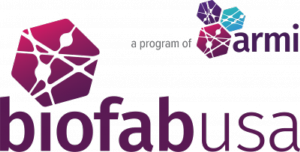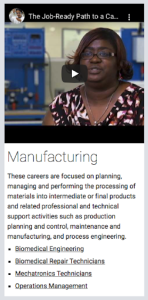UDL Case Study: Biofab Explorer - A Tool for Career Guidance
Biofab Explorer: Invent Your Future is a career guidance tool developed by CAST—a nonprofit education research and development organization—in collaboration with ARMI, the Advanced Regenerative Manufacturing Institute (ARMI)/Biofab USA. ARMI’s mission is to accelerate the large-scale manufacturing of synthetic organs and tissues. Biofab Explorer supports teachers and guidance counselors to expose students to an emerging industry, and shows students how the skills they are building in secondary Career and Technical Education (CTE) programs as well as postsecondary community and technical college programs fit into careers in biofabrication.
research and development organization—in collaboration with ARMI, the Advanced Regenerative Manufacturing Institute (ARMI)/Biofab USA. ARMI’s mission is to accelerate the large-scale manufacturing of synthetic organs and tissues. Biofab Explorer supports teachers and guidance counselors to expose students to an emerging industry, and shows students how the skills they are building in secondary Career and Technical Education (CTE) programs as well as postsecondary community and technical college programs fit into careers in biofabrication.
- Goal: The goal of Biofab Explorer: Invent your Future is to serve as a universally designed career guidance and exploration tool for educators, guidance counselors, and students together, in middle and high school grades. Biofab Explorer supports students in both building knowledge and exploring career pathways in the emerging biofabrication industry, and STEM technician careers, more broadly.
- Delivery Approach: Biofab Explorer is an open educational resource with multimedia learning modules examining the potential large-scale impact of biofabrication technology on chronic diseases as well as individual patient experiences with life-changing medical treatments made possible by bioprinted tissues. The Biofab Explorer Teacher Guide includes activities and an Extended Learning Opportunity (ELO), a type of independent study offered to high school students in New Hampshire.
- Timeline: 2019-2021
This short video describes how Biofab Explorer can support students in exploring pathways, including technician careers, in the biofabrication industry.
A Universally Designed Tool with Accessibility Supports
The design of Biofab Explorer is based upon the principles of Universal Design for Learning (UDL), an evidence-based framework for designing inclusive learning environments, instructional practices, and flexible educational technologies. The UDL framework recognizes the variability in the way people learn and offers guidelines to reduce barriers to learning. The core principles of UDL encourage educators to include multiple means of engagement (the “why” of learning), representation (the “what” of learning”), and action and expression (the “how” of learning; Rose & Meyer, 2002).
Engagement through Co-Design
At the heart of the UDL framework is a strategy to engage learners. Educators can promote engagement by designing learning environments that give students options and autonomy, and that infuse content with relevance, value, and authenticity for all learners. To support engagement, Biofab Explorer was built using co-design—an iterative design process with the end-users (career and technical education students, educators, and guidance counselors)—to understand their preferences. We learned that CTE students are familiar with, and interested in, STEM careers in general but other than biotech concentrators, students are not familiar with biotechnology, biomedical engineering, and biofabrication. Relative to career exploration, students want to know educational requirements, salary, and day-to-day tasks of a job, and like to learn this information via watching videos, job and internship descriptions, reading articles, and listening to podcasts about career paths. The co-design process enabled us to form the structure and content of the learning modules based on the motivations, background knowledge, and preferences of students as career seekers.
Representation in Information Design
To address the variability in the way learners perceive and comprehend information, Biofab Explorer includes options when representing content.
Biofab Explorer Accessibility Features
- Embedded alternative text for images and captions for videos to remove barriers for students with sensory and learning disabilities
- Multi-media glossary of key terms to support variability in learner background, language, and lexical knowledge.
Universally designed content provides options for comprehension, to support active information processing skills; one way to do this is to “highlight patterns, critical features, big ideas, and relationships,” as stated in the UDL Guidelines (CAST, 2018). Biofab Explorer makes big ideas about printing organs more accessible to learners with short videos, graphics, and text. A case story, “The Birth of a New Industry” case story introduces students to the origins of biofabrication and the mission of ARMI, and how the consortium of businesses is working together to accelerate the production of large-scale manufacturing of engineered tissues. Biofab Explorer also makes connections between CTE career clusters and career pathways in the industry. For example, a CTE student studying Manufacturing can see how the skills they are building map to a career as a biomedical repair technician, and see details of the education requirements, salary, and projected job outlook.
Action and Expression in Teacher Guides and Activities
Biofab Explorer offers contextualized and engaging content with personalized points of entry depending on the need of the student or the educator.
Biofab Explorer Features
- Keyboarding options and accessibility features, such as text to speech, built into the navigation
- Options for how to learn about the field, from the perspective of specific career profiles, or from the perspective of the patients receiving treatment made possible by biofabrication technologies
In a lesson on 3D printing, a manufacturing teacher might select the Bioprinter Repair Technician career profile, while a biotech teacher might select the A Cure for Heart Disease resource page, which explains the potential of printing replacement blood vessels for patients.
The Teacher Guide content can be used in teacher-guided classroom lessons, individual exploration, and a guided Extended Learning Opportunity. There are two tiers of activities:
- Level 1 Activities are appropriate for any student, regardless of familiarity with biofabrication, designed for students to demonstrate career readiness.
- Level 2 Activities are designed for students with some familiarity with biofabrication.
The Extended Learning Opportunity (the state of New Hampshire’s term for independent study) provides a way for teachers to enable students to explore topics in biofabrication in an independent study format. Courtney L., a college-bound senior interested in molecular biology, recently completed the Extended Learning Opportunity. She focused her research on building background knowledge in biofabrication and then exploring ethical questions related to the availability and cost of bioprinted organs.
Moving Forward
Biofab Explorer is freely available to educators and students interested in exploring the biofabrication industry. If you have any questions or comments, please reach out to Alison Driscoll ([email protected]).
industry. If you have any questions or comments, please reach out to Alison Driscoll ([email protected]).